Home
AlaskaStories.com
Stories 8...
Page contents:
Cannon: I dunno, society, maybe
Battery: curiosity
Easy Winter Trip: adventure
Gold Claims: adventure
Chitina Dip Netting: fishing
Local Forest: society
And this aint no bullshit...
Cannon
Hey - This story aint done yet, but I decided to upload it
for the photos, on account as I took the pictures with my new
camera. Fellow cannon sorts might like to see the pics of the
cool cannon I made back in '69. Cannon people like to look at
pictures of cannons. I just recently spiffied it up a bit, with
new accouterments. It has a 14 inch barrel, with a 3/4 inch wide
hole in the middle of it. Oh, and among the new accouterments
are the two brass monkeys, the little brass trays that the stacks
of cannon balls sit in. Yes, that is the brass monkey that is
often referenced in relation to its balls on a cold winter day.
Well, the rumor I heard is that on a really cold day the brass
box would contract more than the iron balls, and therefore spill
the balls over the shallow edge. There may have never been a carriage
that looked like this one. I forgot to look at a picture of a
cannon carriage before I made one. I fired this thing a few times
back in the early days, back when black powder was 79 cents per
pound, instead of $20 per pound now because the insatiably power-craving
thugs in the government use every excuse to regulate and bureaucratize
every human activity into unaffordability. The US government thugs
crave exclusive ownership of explosives, while they bomb more
villages and shoot more people, to show the world how malicious
the American bullies are. If you are not laughing yourself to
tears at power-damaged minds, you are missing their only show.
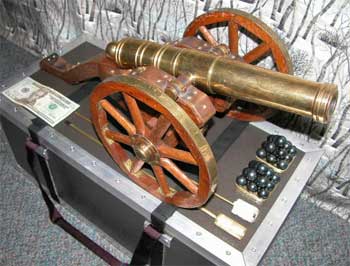 I turned the brass
barrel and trunions on a lathe. They are silver soldered together.
I made the carriage from Black Walnut. The axle is 3/4 inch square
brass stock, turned on the ends, mostly covered with walnut. The
cannon balls are 3/4 steel, heated to turn them black.
I turned the brass
barrel and trunions on a lathe. They are silver soldered together.
I made the carriage from Black Walnut. The axle is 3/4 inch square
brass stock, turned on the ends, mostly covered with walnut. The
cannon balls are 3/4 steel, heated to turn them black.
Cool cannon, huh?
If you live between Alaska and Washington DC, and you notice
a 3/4 inch steel ball whizzing overhead, it might be because I
got some black powder, if that particular shot did not come from
one of the other Alaskans. Sometimes the cannon balls fall short,
but the Canadians pick them up and shoot them further along the
way. International cooperation is strong in the war against the
Washington DC terrorists.
The saga to get some cannon fuse is over a year old. It is
more convenient to put fuse in the little vent or touch hole,
than to use black powder, because powder offers no time to step
back. But the stinkin, pitiably idiot feds made a rule that disallows
fuse to be shipped to Alaska and Hawaii without another truck
load of bureaucratic paperwork that no shipper wants to fill out
for the very few fuse orders. The paperwork does not change the
fuse shipping. It just gives the BATF thugs more budget excuses.
The Americans will replace Rome for that analogy.
Mo on the cannon later, after I get done the things I am supposed
to be working on right now...
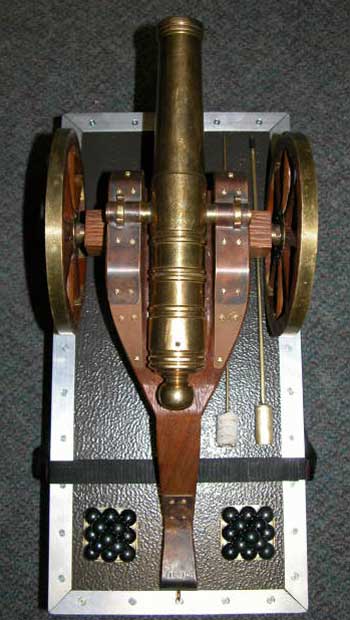
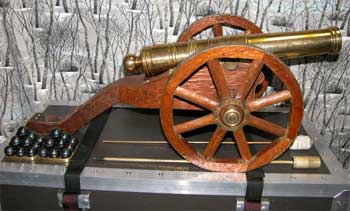
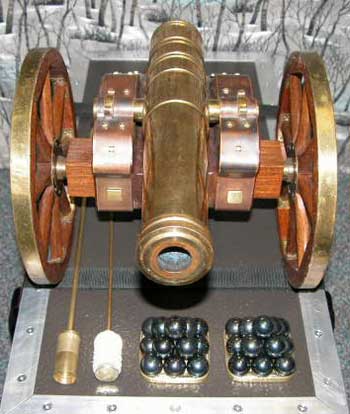
Computer Battery
I have not even finished the above story, or most everything
else I am supposed to be doing, and I uploaded the following photos.
Well, another rather new $200 computer battery for my Apple
Power Book laptop crapped out, so to get my money's worth in entertainment,
I took my pocket knife to it. First I cut off the panel that said:
Caution: Do not disassemble battery. I was tempted to use
my 41 inch carbon steel medieval broadsword, or my .44 Magnum,
but moderation in all things is wise. Then I gouged and pried
and pulled the rest of the plastic off, just to see what cost
200 bucks under that black cover with little green lights at one
end. I thought you might want to see the cheap dollar-two-ninety-eight
plain old common commercial batteries with a couple 79 cent circuit
boards and a few wires. This is why the computer companies got
more money than we victims addicted to these over-priced tools
of questionable utility. If you have wondered what is inside those
battery packs, they all look similar to this one, least ways the
ones I ripped apart for sport. The cost is predicated on the image
of the toy it powers. Probably only one round battery in the rectangular
packet of twelve went bad, as usual. Do not do this at home.

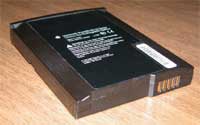
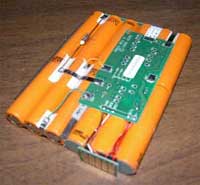
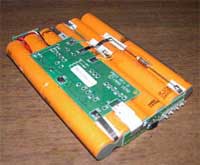

Battery disassembly tools.
An Easy Winter Trip
This is just a typical trip to an Alaska Range foothills cabin,
south of Fairbanks. I forgot to get a picture of the cabin, or
a picture of the inordinately fine wine and culinary artistry
worthy of the view from the cabin. The story is in the photos,
except for the parts about getting the snow machines stuck in
deep snow so often, and other screw-ups we did not photograph.
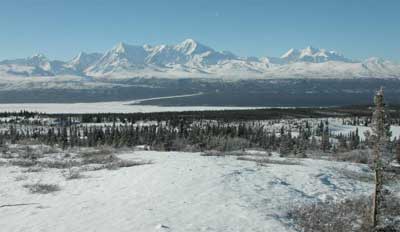
The view from one of the low ridges. The cabin is down in the
trees, with the same view. Looking west over the Delta River and
Richardson Highway, north side of the Alaska Range. Mt. Hayes
on right, Mt. Moffit in center, then Mt. McGinnis.

Closer view of Moffit on the right, McGinnis center left. Climbers
sit in the cabin and tell potential stories about every route
you can see, and some actual stories.
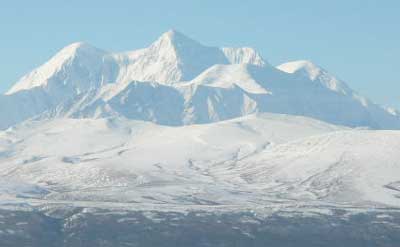
Mt. Hayes

The famous Donnelly Dome. The Richardson Highway passes near
the bottom on this side. The right of passage for Fairbanks climbers
is to walk to the top, because it is there.

How to cross one of the braids of the Delta River. Start.
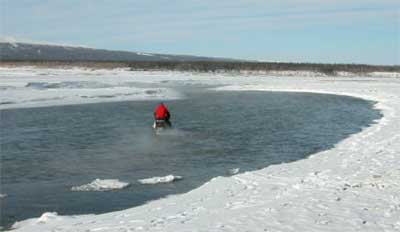
Easy on the throttle, and keep hoping, while slick rocks bump
around under the track.

Whew.
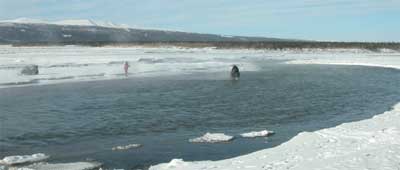
Next.
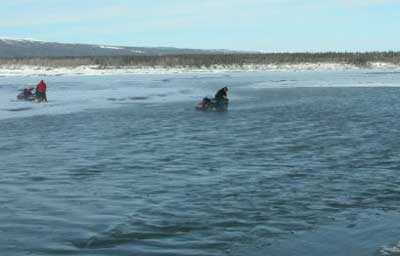
Oooops, close, but not enough hoping. 20 degrees below zero,
and wet feet.
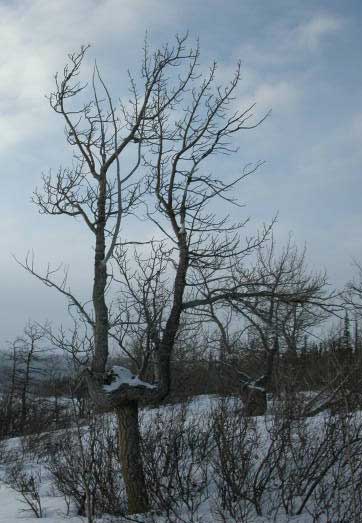
An Ent who was not content with one view of things.

We caught this gathering of old Ents. Survivors. The other
trees were little young sorts, struggling against the spring ice
break-ups and floods from a glacier just upstream.
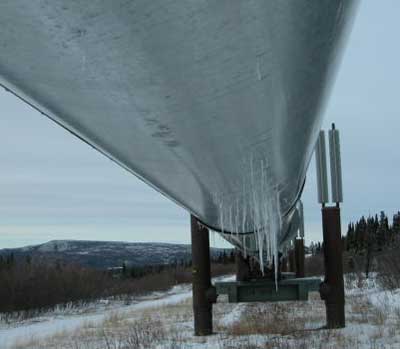
Yes, the Alaska oil pipeline leaks like a sieve. And yes, it
ran out of oil years ago. They pump water through it, just to
keep people fooled. It is a conspiracy. That is why the oil wars
continue, on schedule.
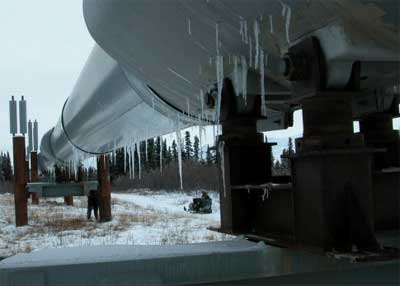
More proof.
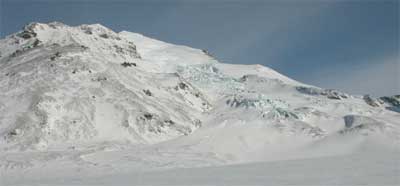
Lunch at the bottom of Mt. Silvertip, the sharp point behind
the ridge in the foreground. Nice hill. Pleasant walk up through
some crevasses.
That's it for the easy snow machine trip to the Alaska Range
cabin. We welded one of the snow machines back together when we
got back. Painted over the weld, and gave it back to the guy who
loaned it to us.
Gold Claim Staking Again
There I was, mind you, and it was desperate indeed, albeit
as usual. I spent all my money again, and had to get a job. Desperate.
Nice thing about Alaska is that there is gold in the hills
up north. It is yours for the taking. If you repeat that old rhetorical
illusion, people will keep believing it, so they go look for the
stuff and pay people like me to stake their gold claims.
Okay, so this is just another typical boring Alaska gold claim
staking story, not like the real adventure stories that are still
in the cardboard boxes which I have not yet had time to grub through
and transcribe to this screen.
Well, looking for gold, and grubbing it out of the ground,
are the easy and fun parts. But the claims have to be staked.
You have to walk to each corner of your claim and put in a post,
at least four feet high and four inches square at the top, or
some variation of similar numbers. These folks who catch the glint
of gold wherever they look tend to want to stake a lot of claims
around them so they can have all the gold to themselves, and no
one else can get too close to their gold. And each claim is some
big number of feet on each side, something like 660 feet, or 1320
feet, or something like that, depending on what sort of claim
it is, and under which government bureaucracy. And the lines between
the posts have to be marked, and the paperwork has to be left
on the northeast post.
Well, the lines between the posts are straight lines, over
or through whatever is in the way, not the comfortable game trails
that go everywhere except where gold claim posts are. So placing
mineral claim posts sometimes takes people where no rational person
would ever go, at great difficulty and aggravation. We such people
therefore sometimes see what no other person sees, some of it
intriguing. Hard way to may a living, but typing these words don't
pay nothing, so I gotta claw my way through the Alaska brush,
over cliffs and all that, so I can afford to type these words.
Off we went, up to the far frozen north, driving the North
Slope Haul Road, during the heat and dust and fires of summer.
In fact the usual forest fires were burning right to the edge
of the road several places. The smoke was thick. Interior Alaska
is a fire ecology. The cycle of fire is mixed into the cycle of
vegetation growth. The summer rain storms drift around the expansive
interior Alaskan boreal forest, in random patterns that leave
dry gaps between them, where lightening strikes to fire up the
random patterns until the next rain storm changes the pattern.
We were driving through the pattern.
We saddled up our four wheeler all terrain ATV motor horses
in the Coldfoot-Wiseman area, and headed into the hills to the
gold claims that needed staking.
This time we were restaking an old claim block on a remote,
historic creek that had already produced no few thousand ounces
of gold, starting back in 1898 or thereabouts. The old claim posts
had long since rotted into the ground, and it is wise (sometimes
imperative) to be able to show real claim posts if you want to
really own the claims. The exact location of the creek shall remain
secret so as to not embarrass the claim owners right out in full
public view. Well, this is how it works. The early Alaska gold
miners got all the easy gold, back when it was hard to get there.
Then the next crop of gold miners got the gold that was harder
to get, when it was getting easier to get there. Then the next
crop of gold miners grubbed even deeper, in harder rock, but with
better equipment transported on the better roads the previous
miners built. And so forth. The harder it is to get, the more
there is. The easier it is to get, the less there is. Each time
they told fabulous gold stories to the next guy, and sold their
claims to him. So now in year 2005 the gold miners are telling
more gold stories and selling more gold claims, than they are
grubbing for the gold that was already grubbed out. But the stories
are still good because those old gold miners did not have the
new high tech technology that can get those remaining pay streaks
on the what's-it's-name side creeks (called pups) where the old
production records indicate major concentrations of gold that
were not pursued because of reason's number 37 through 337.
Some of the reasons that they pander for why the previous miners
did not mine the remaining big pay streaks on the side creeks,
still left for the next guy so he would buy the claims, would
serve Hollywood well. Easy enough to point to their dilapidated
old D-8 Cats rusting into the creeks, or grown over with alder
and moss, with a few flecks of yellow paint peeling off the rust,
and mention the thirty feet of overburden dirt that had to be
moved to get to the bedrock pay streak, that a new D-10 Cat could
easily reach for the big pay-off. You know the stories are getting
thin when they tell about the gin pole that fell over and killed
one of the crew, so the rest of the crew gave up, leaving all
that gold. Many of the stories start out with fascinating technical
analyses of gold mining technique intricacies that get so convoluted
that the listener cannot figure out where the last gold ended
and the next gold starts with which different angle adjustment
on the sluice box in relation to the water volume and the punch
plate hole diameters. "They just didn't have the right sluice
box riffle design. Anyone can see that." "Size five
expanded steel underlaid with Gore-Tex Astro Turf, and maybe a
vibrating jig plant with some Viagra, will recover all the nuggets
and 70 percent of the missed fines"
You would be highly entertained to watch old miners crawling
through the rusted old junk mining equipment from the previous
old miner, and listen to the reasons why said old miner missed
most of the gold with that old equipment.
And we unlimbered our .44's, on account as another couple folks
in Alaska had just been killed by a bear, as usual. We were in
bear country, Alaska.
When the four wheeler road ended at the creek, we kept on going,
mostly right up the middle of the creek, slowly, sometimes very
slowly.
We reached the claim block and camp. This was not the normal
tent adventure. This was a major gold camp, or had been a major
gold camp in previous years. It is that for which a tourist would
demand a refund, but what was so nice that we were a bit embarrassed
to be afforded such luxury, in comparison with the usual tent
adventure. There were mattresses on the floor in the old bunk
house, and a complete roof, and the holes in the window screens
had been repaired. We even had a table and chairs. The permanent
camp crew of three lived even better. They had a hammock beside
the main cabin, that is, until I laid in it, to discover that
no one had laid in that old cotton hammock since the previous
miner put it there. Ooops.
You may have recognized the reference to Coldfoot and Wiseman,
on the Alaska oil pipeline route. You would recognize the wealth
of old surplus pipeline construction materials that seeped back
into the mining camps along that route. This was one of them.
And this were not no old compass and hip chain staking gig
done the hard way. We punched the pre-set claim stake waypoints
into the GPS, and followed the arrow on the screen, albeit up,
down and through all those things the arrow ignored. Yes, scrambling
up and stumbling down the slick moss covered rock cliffs, spitting
out the mosquitoes you inhaled, and getting gouged with broken
alder branches in the otherwise impenetrable thickets seething
with bears laying in wait, is that for which the miner wisely
pays we less wise chaps while the miner leisurely grubs for gold.
We worked from the four wheeler road at and in the creek, back
and forth, stake to stake, moving up the creek. We eventually
reached were the four wheelers would not go up the creek any more.
Then we reached where we could not walk up the creek anymore,
at vertical canyon walls with a torrent of water bouncing off
both sides. And on we went, through the brush on the steep sides
of the canyon, claim post after claim post. Same old stuff.
There were gyr falcons, merlin falcons, ptarmigan, ducks in
the puddle ponds in the tundra, gray jays, dickey brown birds,
yellow warbler sorts of birds, and so forth. We were routinely
harassed by birds protecting their young. A face-off with an angry
ptarmigan is why people fear the Alaska wilderness.
And there were the black bears. The first one was up above
me, busy hoovering in blueberries on a steep open tundra slope
mottled with clumps of brush and stunted trees. I figured as long
as I was quiet, he would not notice me while I put in a claim
stake. But the stake location was in an open area. I had to go
get a small spruce tree, for the stake, from a small clump of
trees a ways from the stake location. Well, at my first chop on
the tree, the bear's perception was moose antlers in the trees.
He instantly wheeled around and was barreling straight down the
hill at what he thought would be moose breakfast steaks. His enthusiasm
and potential ignorance was a bit disconcerting. I ascertained
a full count of rounds in my .44 cylinder. He might have stopped
sooner if he could hear my shouting over his own noise. When he
belatedly recognized that the noise I was making was not normal
for moose or anything else he would prefer to eat, he abruptly
stopped, became noticeably confused, and ran back and forth trying
to find the scent that the breeze would not take to him. My concern
with his confusion was cutting into my staking time, but my partner
across the valley was not getting ahead of me on his side because
he was watching and laughing.
Well,the bear ran back up the hill a ways, and I got back to
work chopping the spruce, and a couple more to make a tripod claim
stake. But then the bear started sneaking back down toward me,
from bush to bush, and finally sat behind a bush, comically peering
out from behind it every minute or so, to try to figure out just
what this was all about. Soon enough I departed, leaving him still
in deep thought. The next bears, a sow with two cubs, at the next
stake, were farther up the hill, and did not notice me. I made
an effort to make less noise. The next black bear was in camp
the next morning. It knocked over a pile of empty barrels, to
assert its management prerogatives.
We were also afforded magnificent meals prepared by the camp
manager who patiently tolerated her husband's gold mining pursuits.
Moose steaks, blueberry pancakes and all that sort of stuff. One
can find the full spectrum of Alaska gold mines run by males,
from bad to worse. And then the ones deftly influenced by women
are pleasant experiences.
Of course you would expect to be paid in gold instead of those
worthless American paper dollars, for a gold claim staking project.
But Alaska gold miners do not have any gold. It is all an illusion.
They work their entire lives at real jobs, to save enough money
to go gold mining, and just keep on mining until all their money
is gone.
Genuine Alaska gold camps are places worthy of the effort to
visit, if you do not run into a volley of rifle and pistol shots,
and are willing to work more than talk. Or just stake your own
claims in the next valley, and make your own gold camp. Alas,
the stinking federal government drones are spending millions of
your tax dollars on armed bureaucrats in helicopters, sanitizing
the old Alaska gold mining camps out of existence, to erase them
from history, except their illusion at the government-authorized
tourist centers saturated with tax paid drones lying if their
lips are moving. If you perceive that any government has ever
told the truth, you are that over which commonly intelligent people
laugh. Why are there any problems after all the governments said
they exist to solve the problems, if their process has not already
proven to be fundamentally flawed while they maintain it and keep
taking your money to reward their perpetual failure? And making
a new gold mine in the US is 90 percent expense for government
paperwork and idiot-drills, leaving you wiser to look for gold
in Russia, helping them advance their nation, and leaving the
Americans to sink on schedule.
As to that matter, after restaking all the claims, surviving
the attacking ptarmigan and returning to the Haul Road, we decided
to look at the ludicrous new federal government Visitors Center
at Coldfoot. Its construction was a recent controversy in Alaska.
Look for Coldfoot Alaska on the map, north of the Yukon River,
on the Haul Road, in the middle of non-descript forest with nothing
to visit. Coldfoot is a privately owned truck stop, with a motel,
a good cafe, gas, and less traffic than any lower 48 truck stop.
But the feds own the land on the other side of the road. If anyone
tries to defend any value of the federal government, start asking
them questions about the federal Visitors Center at Coldfoot Alaska.
One should visit it to discover just how far the federal government
has sunk into its bureaucratic quagmire, and the astonishing stupidity
of the people who will work for it, quite like myself when I did.
When the budgetary illusion for that Visitors Center belatedly
collapses, it will be used for another remote, secret prison to
torture enemy combatants, such as the Alaskans who criticize the
government idiots. Priced at 2 million dollars, for a Visitors
Center where no commonly intelligent person would stop to visit,
the actual cost was later admitted by the government to be 5 million,
as usual, while the contractors said they were paid 6.7 million
of your tax dollars. The building is large and lavish, with noticeably
expensive landscaping and interior decor, for what is only itself,
with no other purpose. At ongoing cost, it produces no benefit
for tax payers.
It gets worse. It is in the center of a major gold mining region
with a fascinating history of humans doing astonishing things
with hand tools and horses, heavy iron and timbers, wool and winter
blizzards, that which would bring modern American laborers to
their knees at the description alone. So, of course, the worthless
wussy government drones at the Visitor Center, lost in their flowery
fields in the sky, ignore the mining history, and present painted
murals of a utopian wilderness on the North Slope, an entirely
different, treeless ecosystem to the north of the Brooks Range.
The Center panders the "save the wilderness" government
illusion that fools fools so the military industrial complex can
kick aside individual human rights, those of the miners and other
Alaskans, to secure lower 48 corporate government control of mineral
and oil wealth. Individual tax payers do not like to pay for the
incessant wars started by mental midget presidents, but government
crony corporations which are handed large mineral and oil reserves,
pay taxes on command, after getting their money from the tax inflated
prices they charge you. The Visitor Center staff of rangers, variously
of Park Service, BLM and such bureaucracies, are laughably clueless
or the real world outside government, hired because they are too
stupid and timid to ask questions of the lies they are told by
their superiors. They are perfect examples of the dutifully dumbed
down America. They could read these words, and still not comprehend
the concept of asking any questions of their superiors. Fortunately
the Coldfoot secret future federal prison is still behind the
trees, not in sight of the Haul Road, but no doubt the government
will pay some "save the wilderness" bureaucrats to slash
the forest and erect more ugly signs to pander the illusion that
their 6.7 million dollar Propaganda Center is a popular attraction.
At this time in history, the current product of the Alaska
gold mines is the old antique mining equipment. The malicious
BLM, Park Service and other armed government thugs with helicopters
are stealing the antiques, where the miners are not present with
enough guns to fend off the government swine. The pictures below
are of a classic old churn drill, at a classic old Alaska gold
camp. It was used to drill holes in the ground to get rock samples
for analyses of gold content. It is a hammer type drill. The motor
pulls the drill stem up when the rope is held taught on the pulley.
The drill stem is then dropped to hit the bottom of the hole,
making dust from rock and hard packed dirt. And the cycle is repeated.
Then water is poured in the hole, and the slurry pumped out, to
be panned to see if there is any gold down there. The greatest
concentration of gold is usually laying on bedrock, or close to
it. It is easier to drill a small hole down to it, rather than
digging a large hole, to find out if there is enough gold to remove
all the overburden for the area.
This antique Fairbanks Drill Company churn drill, with Serial
Number 32, is for sale, for a very reasonable price. You may inquire.
It is a superlative piece of Alaska gold mining history that would
accent any landscape decor. It was the primary drill for many
years at an Alaska gold mine on a remote, famous creek that produced
a lot of gold. Some of the wood may need to be replaced (with
similar old boards which are available). More photos are available.
The greater cost will be getting it out of the hills, back to
Fairbanks, and to wherever anyone wants it. The full story comes
with the drill.
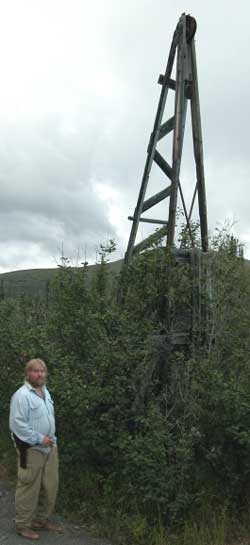
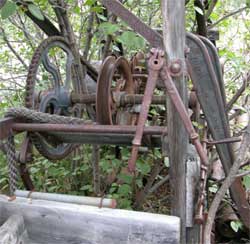


A typical old D-4 Cat and P&H Crane (drag line) rusting
into a typical old Alaska gold mining area. The P&H is rumored
to have come from the Panama Canal construction project.



The Perils at Chitina
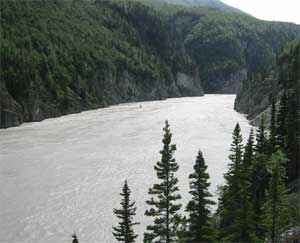 There we were, mind
you, and it was desperate indeed, albeit as usual. We are still
not sure who among us survived. We were getting gaunt. The bottom
of the larder was bare and dry. The famous Copper River Reds were
running in the Copper River. We unlimbered the dip nets.
There we were, mind
you, and it was desperate indeed, albeit as usual. We are still
not sure who among us survived. We were getting gaunt. The bottom
of the larder was bare and dry. The famous Copper River Reds were
running in the Copper River. We unlimbered the dip nets.
Chitina dip netting involves standing next to the river with
a long-handled net in the water, waiting for a salmon to swim
into the net. Easy. And sometimes you get to sit down, if you
pick the secret fishing spot.
It don't get more boring than this, but that is preferable
to the alternative in the Chitina canyon of the Copper River.
It is a big river, with an impressive volume of glacier water
rushing past vertical rock walls. The eddies and swirls and frighteningly
roiling currents are frightening and roiling. If it gets exciting,
it is because you fell in, are wet, cold, and on a fast trip past
a lot of rock cliff, with little hope of surviving. The massive
eddy on the right side below the canyon will get anyone who gets
past the other eddies. Boredom is sometimes welcome.
The huge government sign stated in bold red letters that the
road was closed, with passage prohibited, unlawful, extremely
dangerous and could result in serious injury and DEATH. A few
people watched us drive past the sign, through the creek, and
up the steep hill to the Copper River Road past O'Brien Creek.
The sign scares the timid, primarily those who are too ignorant
to realize that the government dolts are lying approximately 100
percent of the time, sometimes more.
The road, a public right of way, was the temporary construction
road for the old abandoned railroad that was used to haul the
copper ore from the McCarthy Mine, down the river to the coast.
Remnants of the many heavy beam railroad trestles crossing the
side creeks, and perched beside the vertical cliffs, stand among
the trees or lay among the brush and rocks. If you ever wondered
if there is a real cliff road like you see in the comic books,
the road that is carved out of the cliff above the raging river
far below, zig zagging in and out around vertical cliffs, there
is. This is it. Check it out sometime, but prepare your mind.
And do not discuss earthquakes.
No one on the road is bold. The rock is slippery schist, all
sloping downward toward the river, and crumbling. Everyone is
wisely cautious, driving slow, politely, and thinking good thoughts,
especially on the corners around the buttresses. The view to the
raging river below cannot be avoided. Practice 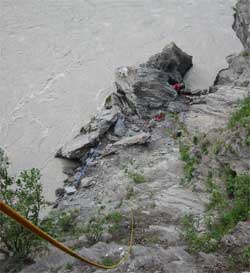 clenching
your teeth. Some people whistle.
clenching
your teeth. Some people whistle.
Dip netting for salmon on the Copper River, by Chitina, is
a popular thing in Alaska. It is one of the remnant freedoms that
is passionately hated by the government swine and their corporate
cronies. The common peasants can efficiently get high quality
food for the freezer, without paying the government all manner
and layers of taxes charged for the other ways to get food. The
government refuses to maintain the public road used for Chitina
dip netting. The multi-millionaire Alaska Native Corporations,
awash in oil tax money slipped to the Corporations and their countless
"non-profit" bureaucracies, by the legislators they
own, attempt all manner of threats and legalistic ploys to stop
the common people from getting the salmon that the government's
heavily taxed corporations could otherwise catch, then sell back
to the people at tax inflated prices. If you are not laughing
robustly at what happens to human minds which become victims of
foolishly accepting power, your are missing the only show those
mud-hole swine know how to stage. Of course I apologize for slighting
the good character of farmyard pigs by equating them to the repugnant
government thugs and their pocket corporate cronies.
Our jaw muscles became tired from clenching our teeth at too
many places which were too unnerving to describe, including the
places where the road in front of us dropped down so steep we
could not see it over the hood. We finally pulled over, a few
inches, at a wide spot on the road, just wide enough to park a
car, but not enough to get out on the down cliff side.
Depending upon the fish run, or fish swim, at the time you
get there, Chitina dip netting can be a two hour adventure to
catch your limit, or a four day adventure, or more. Wise people
bring a tent and plan to stay. There are no tent places along
the road, except on the road, at the wide places, on the rocks.
Cars drive slowly past the parked cars and tents.
Two of us left Fairbanks in the evening, and got to our secret
fishing spot a 1:AM. The secret fishing spot is always the one
that is not occupied when you get there. If it is occupied, go
to the next spot. All the spots are obvious. They are where you
can park a car. They have a trail leading down over the edge,
to the first tree or large bush clinging to the cliff, where you
wisely tie a rope and lower yourself the rest of the way to the
water, usually over a hundred feet. Or just tie the rope to your
car. Set the brake. Then you usually tie yourself to the rocks
where you are dip netting. If you fall in the very cold glacial
water, no one will be able to save you. People die when Chitina
dip netting. Stay tied in.
There are a few places that are not as desperate as described
herein, where side creeks enter the river, but they are few and
crowded and not as good dip netting. Of course the secret spot
we picked requires a rope to get to, but has a magnificent flat
place to walk around, and sit down, at water level, if high water
is not washing over it.
Each spot is a bit different. You want to find a place where
one or two points on the vertical cliff jut out a ways into the
current, creating a back-eddy against the cliff, between or below
the points, where the fish concentrate along the edge to swim
with the advantage of the upstream current or back-eddy, so when
you put your long  handled
dip net in the water, the back-eddy current keeps the net open
upstream, and the fish swim upstream into the net. It is hard
work holding the net in even the most favorable current, and the
currents in the roiling water irradically change. Sometimes you
can tie the net off to a rock, so the rope and the current and
the handle you are holding, hold the net in place, but it is still
hard work handling the net. And sometimes you can sit down, and
hold the net with your foot, just out from a corner of a rock
where the salmon are coming around the corner. If you do not have
a back-eddy, you have to dip the net in the current upstream,
and sweep the net downstream to keep the net open, and hope you
encounter a fish in those few seconds before you have to do that
again, and again, and again.
handled
dip net in the water, the back-eddy current keeps the net open
upstream, and the fish swim upstream into the net. It is hard
work holding the net in even the most favorable current, and the
currents in the roiling water irradically change. Sometimes you
can tie the net off to a rock, so the rope and the current and
the handle you are holding, hold the net in place, but it is still
hard work handling the net. And sometimes you can sit down, and
hold the net with your foot, just out from a corner of a rock
where the salmon are coming around the corner. If you do not have
a back-eddy, you have to dip the net in the current upstream,
and sweep the net downstream to keep the net open, and hope you
encounter a fish in those few seconds before you have to do that
again, and again, and again.
The cliffs enter the water vertically through most of the canyon.
There are only so many places where a person can stand, perch
or cling to the rocks at water level. And the water level changes
dramatically, sometimes many feet, sometimes while you are there.
When we arrived, we debated setting up the tent, off one end
of the car, and getting some sleep, but when the fish are running
(swimming), a person does not want to be sleeping, because when
they are not running, the next run might be a day or more away.
We decided to go down and check if the fish were swimming. Mountain
climbers have the advantage of fancy rope gear. We put on our
harnesses, tied the rope to a tree, and lowered down the steep
rock, with an ascender for a safety device. The secret spot we
chose is one of the best in the canyon, with a large level area
not requiring one to be tied to the cliff. Tell no one where it
is.
The fish were running. There would be no sleeping. Alas, the
run was sporadic, so it took 12 hours to get our limits. A long
12 hours.
The individual limit is 15 salmon, Red or Silver, with only
one being a King. The normal household limit is 30 fish. This
time there was a temporary limit increase of 10 fish, due to the
large run. The limit of Kings is always only one per dip netter.
It should be larger, for both Kings and the other salmon, but
the insatiably greedy commercial fishermen, most of them from
Seattle, who own most of the Alaska State legislators, and always
own the State Fisheries Board appointed by their pocket governor,
take over 95 percent of the Alaska salmon, and are incessantly
trying to get more by reducing the sport and subsistence limit.
The commercial fishermen want to catch all the 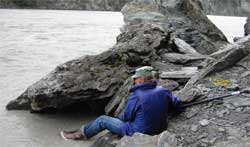 salmon
and sell them back to the common Alaskans. Not many Alaskans would
throw a lifeline to a sinking commercial salmon fisherman. They
say they are nice guys, then their lobbyists try to cut the number
of salmon common Alaskans are allowed to catch for food. They
are much like the Washington DC sorts.
salmon
and sell them back to the common Alaskans. Not many Alaskans would
throw a lifeline to a sinking commercial salmon fisherman. They
say they are nice guys, then their lobbyists try to cut the number
of salmon common Alaskans are allowed to catch for food. They
are much like the Washington DC sorts.
We were dip netting and bad-mouthing government thugs, as usual,
when rocks suddenly came tumbling down the overhanging rock above
our heads. We scrambled, avoiding being hit by the falling rocks,
and managed to not fall into the river. We shouted at whatever
clumsy oafs were carelessly messing around at the edge of the
road above us. There was no response. Curious, one of us climbed
up the rope a ways, to discover some seagulls at the edge of the
road, trying to look innocent, but snickering. The perils of Chitina
dipnetting are many and varied. An open cooler, half full of food,
floated by in the river. Some one upstream was probably describing
the event with different words.
Small river charter boats occasionally brought dip netters
down through the canyon. They turn back upstream, and carefully
place their bow against the rocks where the dip netters get out.
It is often a tricky maneuver. Running a boat through the canyon
is not too difficult, but a bit of an adrenalin rush going back
upstream amid the floating logs and snags routinely coming down
the river with great force. Do not hit anything floating downstream.
It will not bump aside.
You can usually feel the fish hitting the net, but not always
in the strong currents. Sometimes you bring up the net with two
or more salmon in it. King salmon hit the net with a significant,
thunk, a lot of weight. A King in the net requires a bit more
effort, especially at the precarious places. And sometimes 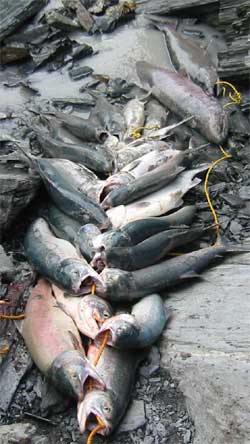 the fish get out before you get
the net up. It is tiring work. Cleaning the salmon is part of
it all. And hauling them back up the cliff is no small effort.
Take a good pack with extra plastic sacks.
the fish get out before you get
the net up. It is tiring work. Cleaning the salmon is part of
it all. And hauling them back up the cliff is no small effort.
Take a good pack with extra plastic sacks.
You will want some ice chests, with ice. Ice is not cheap in
Chitina. If you are coming from Fairbanks, you may know the spot
to get glacier ice in the Alaska Range, at the cost of carrying
it a short ways.
Then there is the matter of the roe, the fish eggs. Gourmet,
way expensive delicacy, golden caviar. Most Alaskans pitch the
eggs to the ever-present sea gulls, and make comments about devising
some way to more easily prepare them, and maybe saving them next
year. They taste like fish eggs, and require a lot of effort to
prepare. I think I have some in the freezer from a couple years
ago. Time to give them to someone who owns a dog. But when someone
shows up at a party, with well-prepared golden caviar, they are
appreciated.
Bald eagles are almost always in sight.
So we caught the salmon and hauled them up to the car. We very
carefully turned around at the wide spot, and proceeded back along
the road of fear. Some of the people who disappeared in Alaska,
were last seen trying to turn around on the Copper River Canyon
road.
This is how amusingly stupid the Alaska State Department of
Transportation personnel display themselves, among many other
never-corrected examples I may list some day. The dumbing down
of America describes government personnel, as they openly display,
and the career sorts who make these laughably stupid decisions
hire the next crop of even dumber chaps to make the superiors
look good by comparison. Part way back we encounter another huge,
expensive, tax paid road sign identical to the first one, stating
that the road is closed and passage is prohibited, facing the
return direction we were traveling. Therefore, if we were to believe
the government, and comply with the law, we would have been required
to stop, and proceed no further, and be stuck there the rest of
our lives. There is no outlet or entrance to the Copper River
road on that side of the sign. It is a dead end road, at the million
dollar bridge that failed and was never repaired. The Alaska State
Government, currently under the Murkowski Family Regime of nepotists
and other intellectually void drones, like the feds, are so zealously
attempting to stop everyone from doing anything, under penalty
of fines and jail, they even want to stop the people from getting
back from where they were not allowed to go.
We survived. Of course we stopped in downtown city center Chitina,
and did the usual cultural tour, which means checking the current
art at Spirit Mountain Artworks. The It'll Do Cafe, didn't. Apparently
it sank so much on one side that the customers slid back out the
door before they could reach a table. Things change.
The salmon, served with fresh Alaska wild morels that we get
more easily than getting salmon, no small amount of fine wine,
and wild-assed stories too outrageous for even this website, were
thereupon the order of the usual pot luck dinner functions. Those
are some of the morels in the last pic.
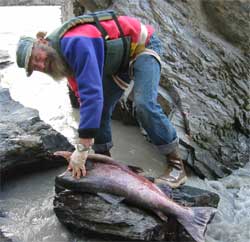
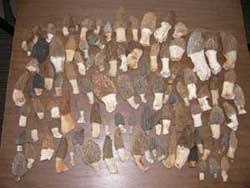
Local Forest
Fairbanks is the end of significant habitation on the road
going North, for the wealthiest society of our times, so there
is an interesting diversity of expressions in the area. I come
upon such expressions while walking in the local forest, now and
again, and therefore may add photos of such things to this section,
from time to time, if I get around to it.
Apparently Buddha does not reside only in those stuffy old
monasteries.
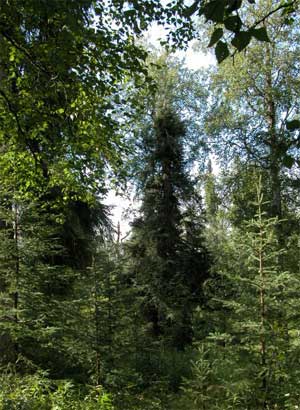

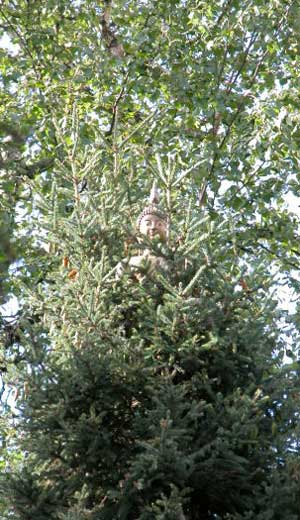
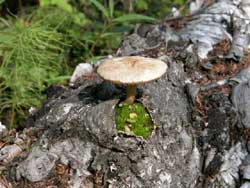
And a cute little log shroom with its own front yard.
Stories 9
Stories 10
Stories 11
Stories 12
Stories 13
Stories 14
Stories 1
Stories 2
Stories 3
Stories 4
Stories 5
Stories 6
Stories 7
Places
Concepts
Smoking
Smoke Photos
Smoke Others
Stuff
Links
Home
 I turned the brass
barrel and trunions on a lathe. They are silver soldered together.
I made the carriage from Black Walnut. The axle is 3/4 inch square
brass stock, turned on the ends, mostly covered with walnut. The
cannon balls are 3/4 steel, heated to turn them black.
I turned the brass
barrel and trunions on a lathe. They are silver soldered together.
I made the carriage from Black Walnut. The axle is 3/4 inch square
brass stock, turned on the ends, mostly covered with walnut. The
cannon balls are 3/4 steel, heated to turn them black.




























 There we were, mind
you, and it was desperate indeed, albeit as usual. We are still
not sure who among us survived. We were getting gaunt. The bottom
of the larder was bare and dry. The famous Copper River Reds were
running in the Copper River. We unlimbered the dip nets.
There we were, mind
you, and it was desperate indeed, albeit as usual. We are still
not sure who among us survived. We were getting gaunt. The bottom
of the larder was bare and dry. The famous Copper River Reds were
running in the Copper River. We unlimbered the dip nets. clenching
your teeth. Some people whistle.
clenching
your teeth. Some people whistle. handled
dip net in the water, the back-eddy current keeps the net open
upstream, and the fish swim upstream into the net. It is hard
work holding the net in even the most favorable current, and the
currents in the roiling water irradically change. Sometimes you
can tie the net off to a rock, so the rope and the current and
the handle you are holding, hold the net in place, but it is still
hard work handling the net. And sometimes you can sit down, and
hold the net with your foot, just out from a corner of a rock
where the salmon are coming around the corner. If you do not have
a back-eddy, you have to dip the net in the current upstream,
and sweep the net downstream to keep the net open, and hope you
encounter a fish in those few seconds before you have to do that
again, and again, and again.
handled
dip net in the water, the back-eddy current keeps the net open
upstream, and the fish swim upstream into the net. It is hard
work holding the net in even the most favorable current, and the
currents in the roiling water irradically change. Sometimes you
can tie the net off to a rock, so the rope and the current and
the handle you are holding, hold the net in place, but it is still
hard work handling the net. And sometimes you can sit down, and
hold the net with your foot, just out from a corner of a rock
where the salmon are coming around the corner. If you do not have
a back-eddy, you have to dip the net in the current upstream,
and sweep the net downstream to keep the net open, and hope you
encounter a fish in those few seconds before you have to do that
again, and again, and again. salmon
and sell them back to the common Alaskans. Not many Alaskans would
throw a lifeline to a sinking commercial salmon fisherman. They
say they are nice guys, then their lobbyists try to cut the number
of salmon common Alaskans are allowed to catch for food. They
are much like the Washington DC sorts.
salmon
and sell them back to the common Alaskans. Not many Alaskans would
throw a lifeline to a sinking commercial salmon fisherman. They
say they are nice guys, then their lobbyists try to cut the number
of salmon common Alaskans are allowed to catch for food. They
are much like the Washington DC sorts. the fish get out before you get
the net up. It is tiring work. Cleaning the salmon is part of
it all. And hauling them back up the cliff is no small effort.
Take a good pack with extra plastic sacks.
the fish get out before you get
the net up. It is tiring work. Cleaning the salmon is part of
it all. And hauling them back up the cliff is no small effort.
Take a good pack with extra plastic sacks.




